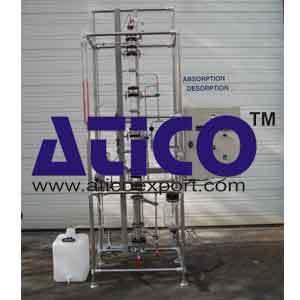Manual Absorption Desorption Pilot Plant
Main characteristics of the pilot
Manual Absorption Desorption Pilot Plant
- Industrial instrumentation
- Borosilicate glass and stainless steel AISI 316L manufacturing
- Rigid process pipes
- Cooling at the bottom of the column
- Continuous or batch processes
Principle of Working:
The absorption process is a mass transfer of a compound present in a gaseous phase to a liquid phase by dissolution. The inverse transfer operation of a gas dissolved in a liquid using an inert gas is called desorption. These processes are done in a packed column between a climbing gaseous effluent and a solution or a solvent flowing down (counter-current operation). The presence of packing increases the liquid-gas exchange surface, therefore the mass transfer.
A heat exchanger at the bottom of column allows to cool the out flowing solution (the absorption is an exothermic reaction); in batch mode this heat exchanger allows to check the influence of the temperature on the efficiency of the absorption. A static mixer, situated upstream of the gas introduction in the column, is used to dilute the gas to process with an inert gas (air or nitrogen).
Teaching objectives
- Study of the following experimental parameters :
- Study of the hydrodynamics of the column.
- Study of the absorption without chemical reaction.
- Study of the absorption with chemical reaction.
- Influence of the head loss on the efficiency of the column.
- Continuous or batch functioning.
- Study of the desorption by an inert gas.
- Calculations :
- Thermal balance.
- Mass balance.
- Determination of the number of theoretical stages (McCABE and THIELE, KREMSER and BROWN).
- Determination of the number of transfer units
- Coefficient of mass transfer.
Technical Specifications of Manual Absorption Desorption Pilot Plant
Equipment:
- Storage tank of the feeding solution or the feeding solvent in polyethylene.
- Feed solution metering pump, AISI 316L stainless steel body, P.T.F.E. diaphragm, manual control..
- Traps for pressure drop measurement.
- Column in borosilicate glass, in three elements with “RASCHIG” rings packing in borosilicate glass.
- Four plates made of AISI 316L stainless steel, equipped each with sampling valves (gaseous phase and liquid phase) and with a temperature plug.
- Head of column in borosilicate glass, NB50, with introduction of the solution or the solvent and draining off the gaseous phase.
- Bottom of column in borosilicate glass, NB50, with introduction of the gaseous phase.
- Vertical heat exchanger, borosilicate glass body AISI 316L stainless steel exchanger.
- Adjustable liquid seal.
- Solution receiver in borosilicate glass, equipped with a draining valve made of AISI 316L stainless steel.
- AISI 316L stainless steel connecting tubes for the process and reinforced PVC for cooling fluid tube.
- Support framework with AISI 304L stainless steel tubes, aluminium connecting nuts and adjustable feet.
Instrumentation:
- Supply of the cooling water of the heat exchanger equipped with a variable area lowmeter with its adjusting valve.
- Measurement of the column pressure drop by differential “U” type manometer.
- Control cabinet, IP55, equipped with an emergency stop button, operating buttons and the following interfaces :
- Two temperature digital indicators with nine Pt100 Ω type probes
Dimensions and weight
- 1, 3 x m 0, 75 x m 2, 9 m ~ 120 kg.
Essential requirements
- 230 V / 50 Hz / Single phase : 0.5 kW.
- Cold water 20 °C / 3 bar : 600 l/h.
- Compressed air / 6 bar : 20 Nm3/hs
- Reactive gas with relief valve 3 bar : 1 Nm3/h
- Evacuation of the toxic gases
- Drain







